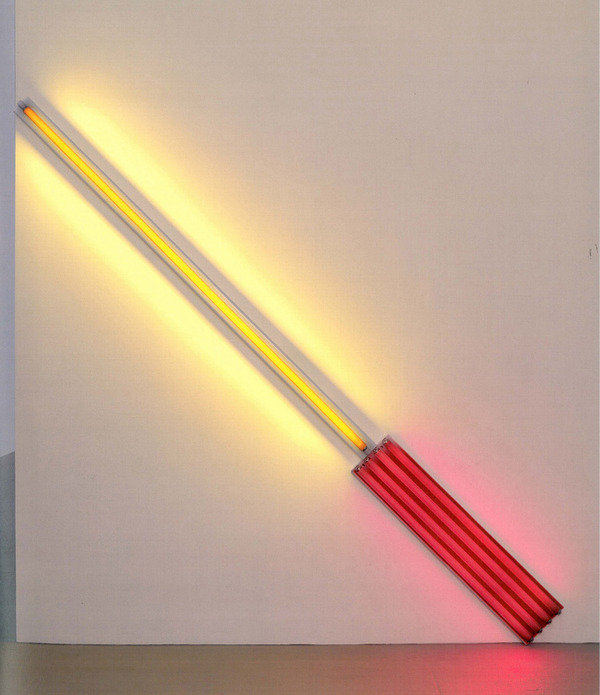Dan Flavin
dal 11/10/2012 al 2/2/2013
Segnalato da
11/10/2012
Dan Flavin
Museum Moderner Kunst MUMOK, Wien
Lights. In the early 1960s, US artist Dan Flavin (1933-1996) began using commercially available fluorescent tubes in standard sizes and colours to create an unmistakable oeuvre. A representative overview of Flavin's light works with around 30 works, the spectrum stretches from selected icons through the early individual and seminal works constructed of fluorescent tubes, to the serial and large-scale, room-filling works.

Curator Rainer Fuchs
In the early 1960s, US artist Dan Flavin (1933–1996) began using commercially
available fluorescent tubes in standard sizes and colours to create an unmistakable
oeuvre. Therein precision and careful calculation are bound together with a sensual
aura. The Dan Flavin – Lights exhibition is the first representative overview of Flavin’s
light works to be shown in Austria. The exhibition elucidates the early development
of his work starting with selected icons and reaches from crucial individual works
comprising fluorescent tubes to the later serial and large-scale installations. The
mumok show comprises 30 works and makes visible Flavin’s artistic diversity and the
developmental possibilities inherent in commercially available fluorescent tubes,
which he knew how to exploit with such impressive consistency. These tubes include
the first “golden” tube placed diagonally on the wall; the “monuments” for V. Tatlin;
and room installations such as an artificial barrier of blue, red and blue fluorescent
light (to Flavin Starbuck Judd), 1968.
By choosing the tubes as both motif and material for his works, Flavin signalled the
increasing proximity of art with everyday life and the consumer world. The ways in
which they are presented derive from principles of minimalist sobriety, though these
are simultaneously and colourfully outshone. The transcendence of traditional art
genres and materials is thereby created and can be found, in a preliminary stage, in
the so-called icons (1961–1964). Here, the body of the image loses its defining
borders through the use of commonplace light bulbs and/or fluorescent tubes.
The icons replace the sacred meaning of light with profane illumination reminiscent
of neon signs and everyday room lighting. This liberation from conventional light
mysticism also reflects the artist freeing himself from his own religious upbringing.
The icons transform the image into a shining wall object prior to Flavin erasing the
remains of then current notions of what a picture is by affixing fluorescent tubes
directly to the wall in predetermined configurations.
In the diagonal of May 25, 1963 (to Constantin Brancusi), 1963, the tube appears for
the first time as an uncompromising object of a luminary self-staging. Lacking
anything extraneous, the work develops a luminous power that not only suspends the
usual boundaries between work, room and viewer, but also the dividing line between
rational form and poetic appearances.
Flavin’s light works do not only refer to current, everyday experience but they also
indicate a modernism where the aspiration of the democratizing and functional
aspect of art is part of bringing about social change. This becomes clear when the
tubes are assembled into towers of geometric forms such as in the “monuments” for
V. Tatlin (from 1964 on), which have been inscribed into art history. This series of
works, which continued into the 1990s, relates to the design of an unrealized office
building by the Russian artist-engineer Vladimir Tatlin for the Third International.
On the one hand, Flavin is referring to the Constructivists’ professed faith in
industrialization. On the other hand, it shows their influence on Flavin’s own pictorial
language as well as the material and formal language of Minimal Art in general. The
dedications contained in the titles to close relatives and friends, as well as
personalities from the art world, political representatives and historical events, reflect
the intermingling of Flavin’s artistic and social concerns. This decisively differentiates
him from fellow artists such as Donald Judd or Robert Morris and the Minimal Art
programme proclaimed by them, which rejected everything personal, subjective and
political.
In the exhibition, the European Couples, a group of rectangle works are a highlight of
spatially referential light art. Their fluorescent tube squares dissolve the corners of
the room and immerse viewers in an imaginary, intermingled, blurred colour space.
Drawings will be presented together with the light works. These document both
Flavin’s process of planning for the works and his artistic sensitivity.
The exhibition has been organized in collaboration with the Kunstmuseum St. Gallen
and with the support of the Estate of Dan Flavin and Stephen Flavin. Dan Flavin’s
inexhaustible, and simultaneously precise, way of dealing with various spatial and
architectural concepts will be able to be experienced firsthand as a result of the
changes in presentation resulting from the differences in the exhibition spaces in
Vienna and St. Gallen.
Publication for the exhibition
A catalogue will be published for the exhibition by Hatje Cantz Verlag containing
articles by Rainer Fuchs, Karola Kraus, Stefan Neuner, Juliane Rebentisch and
Roland Wäspe.
Thanks are due to the main sponsor of the exhibition, Deloitte, the mumok sponsor, UNIQA, as well as
Megaboard and the media partner Der Standard.
Image: alternate diagonals of March 2, 1964 (to Don Judd), 1964. Rote und gelbe Leuchtstoffröhre / red and yellow fluorescent light 366 cm lang über die Diagonale / 366 cm long on the diagonal. The Estate Collection David Zwirner. Photo: Billy Jim, New York © Stephen Flavin/VBK Wien, 2012
Press contact
Barbara Hammerschmied Phone +43 1 52500-1450 Fax +43 1 52500-1300 barbara.hammerschmied@mumok.at - press@mumok.at
Press Conference: October 12, 2012, 10.00 a.m.
Opening: October 12, 2012– 7.00 p.m.
MuseumsQuartier
Museumsplatz 1, A-1070 Wien
Opening hours
Monday: 2–7 p.m.
Tuesday to Sunday: 10 a.m. to 7 p.m.
Thursday: 10 a.m. to 9 p.m.
Tickets
Normal € 10,–
Reduced € 8,– or € 7,–



